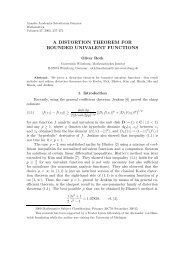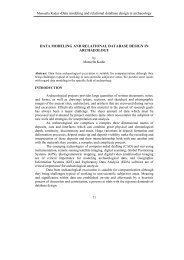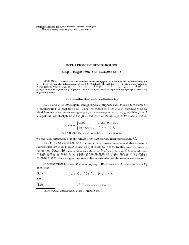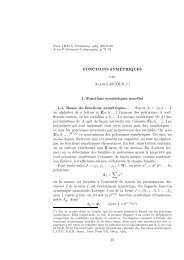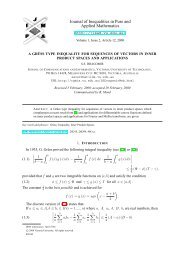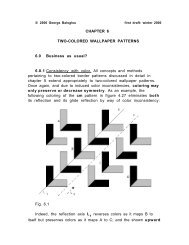SUPERNOMIAL COEFFICIENTS, BAILEY'S LEMMA AND ROGERS ...
SUPERNOMIAL COEFFICIENTS, BAILEY'S LEMMA AND ROGERS ...
SUPERNOMIAL COEFFICIENTS, BAILEY'S LEMMA AND ROGERS ...
Create successful ePaper yourself
Turn your PDF publications into a flip-book with our unique Google optimized e-Paper software.
22 S. O. WARNAAR[18] B. Gordon, A combinatorial generalization of the Rogers–Ramanujan identities, Amer.J. Math. 83 (1961), 393–399.[19] G. Hatayama, A. N. Kirillov, A. Kuniba, M. Okado, T. Takagi and Y. Yamada, Characterformulae of ŝl n-modules and inhomogeneous paths, Nucl. Phys. B 536 [PM] (1999),575–616.[20] V. G. Kac and D. H. Peterson, Infinite-dimensional Lie algebras, theta functions andmodular forms, Adv. in Math. 53 (1984), 125–264.[21] A. N. Kirillov, New combinatorial formula for Hall–Littlewood polynomials, math.QA/-9803006.[22] C. Krattenthaler, private communication.[23] I. G. Macdonald, Affine root systems and Dedekind’s η-function, Inv. Math. 15 (1972),91–143.[24] I. G. Macdonald, Symmetric Functions and Hall Polynomials, 2nd edition, (ClarendonPress, Oxford, 1995).[25] S. C. Milne, An elementary proof of the Macdonald identities for A (1)l, Adv. in Math.57 (1985), 34–70.[26] S. C. Milne, Classical partition functions and the U(n + 1) Rogers–Selberg identity,Discrete Math. 99 (1992), 199-246.[27] S. C. Milne, A q-analog of a Whipple’s transformation for hypergeometric series inU(n), Adv. in Math. 108 (1994), 1–76.[28] S. C. Milne and G. M. Lilly, The A l and C l Bailey transform and lemma, Bull. Amer.Math. Soc. (N.S.) 26 (1992), 258–263.[29] S. C. Milne and G. M. Lilly, Consequences of the A l and C l Bailey transform and Baileylemma, Discrete Math. 139 (1995), 319–346.[30] P. Paule, On identities of the Rogers–Ramanujan type, J. Math. Anal. Appl. 107 (1985),225–284.[31] P. Paule, The concept of Bailey chains, Publ. I.R.M.A. Strasbourg 358/S-18, (1988),53–76.[32] L. J. Rogers, Second memoir on the expansion of certain infinite products, Proc. LondonMath. Soc. 25 (1894), 318–343.[33] L. J. Rogers, On two theorems of combinatory analysis and some allied identities, Proc.London Math. Soc. (2) 16 (1917), 315–336.[34] L. J. Rogers and S. Ramanujan, Proof of certain identities in combinatory analysis,Proc. Cambridge Phil. Soc. 19 (1919), 211–216.[35] A. Schilling and M. Shimozono, Bosonic formula for level-restricted paths,math.QA/9812106.[36] A. Schilling and S. O. Warnaar, A higher level Bailey lemma: proof and application,The Ramanujan Journal 2 (1998), 327–349.[37] A. Schilling and S. O. Warnaar, Inhomogeneous lattice paths, generalized Kostka polynomialsand A n−1 supernomials, Commun. Math. Phys. 202 (1999), 359–401.[38] I. J. Schur, Ein Beitrag zur additiven Zahlentheorie und zur Theorie der Kettenbrüche,S.-B. Preuss. Akad. Wiss. Phys.-Math. Kl. (1917), 302–321.Instituut voor Theoretische Fysica, Universiteit van Amsterdam, Valckenierstraat65, 1018 XE Amsterdam, The NetherlandsE-mail address: warnaar@wins.uva.nl



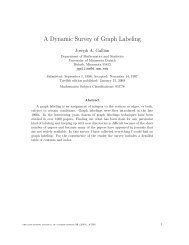


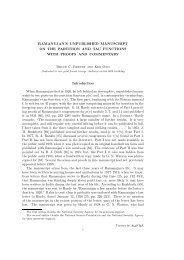
![(.,t ] and [s, .) , where [s,t ] = {s' GT; s ¤ s' ¤ t} , (.,t ] = {s' GT; s' ¤ t} and ...](https://img.yumpu.com/43303393/1/184x260/t-and-s-where-st-s-gt-s-a-s-a-t-t-s-gt-s-a-t-and-.jpg?quality=85)


